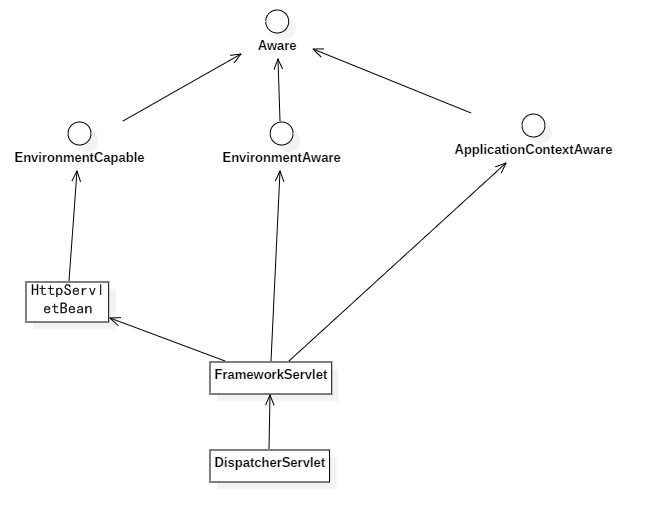springmvc中Dispatchservlet繼承體系詳解
springmvc中Dispatchservlet繼承體系詳解與原始碼分析
一、Dispatchservlet繼承體系

在這一篇文章中,我主要說一下HttpServletBean、FrameworkServlet、DispatcherServlet的建立過程。
首先,我們看到這三個類直接實現了3個介面:EnvironmentCapable、EnvironmentAware、ApplicationContextAware。我們先來看下這3個介面都能幹什麼
- ApplicationContextAware:類似如XXXAware型的介面,表示對XXX可以進行感知,通俗解釋就是:如果在某個類中想要使用spring的一些東西,就可以通過實現XXXAware介面來告訴spring,spring看到後就能給你傳送過來,而接收的方式就是通過實現該介面的唯一方法setXXX()。
public interface ApplicationContextAware extends Aware { /** * Set the ApplicationContext that this object runs in. * Normally this call will be used to initialize the object. * <p>Invoked after population of normal bean properties but before an init callback such * as {@link org.springframework.beans.factory.InitializingBean#afterPropertiesSet()} * or a custom init-method. Invoked after {@link ResourceLoaderAware#setResourceLoader}, * {@link ApplicationEventPublisherAware#setApplicationEventPublisher} and * {@link MessageSourceAware}, if applicable. * @param applicationContext the ApplicationContext object to be used by this object * @throws ApplicationContextException in case of context initialization errors * @throws BeansException if thrown by application context methods * @see org.springframework.beans.factory.BeanInitializationException */ void setApplicationContext(ApplicationContext applicationContext) throws BeansException; }
- EnvironmentAware同上
- EnvironmentCapable:顧名思義,該介面表示具有Environment的能力,也就是可以提供Environment,該介面唯一的方法就是getEnvironment(),它將返回一個Environment物件。
public interface EnvironmentCapable {
/**
* Return the {@link Environment} associated with this component.
*/
Environment getEnvironment();
}
在HttpServletBean中的Environment裡面封裝了ServletContext、ServletConfig、JndiProperty、系統環境變數和系統屬性
<init-param>
<param-name>contextConfigLocation</param-name>
<param-value>classpath*:/spring/spring-mvc*.xml</param-value>
</init-param>
看完整體結構,接下來分別看一下spring中三個類的具體建立過程。
二、HttpServletBean
我們知道,在servlet建立過程中可以直接呼叫無參的Init方法,HttpServletBean的init方法如下:
@Override
public final void init() throws ServletException {
if (logger.isDebugEnabled()) {
logger.debug("Initializing servlet '" + getServletName() + "'");
}
// 將servlet中配置的引數封裝到pvs變數中,requiredProperties為必需引數
try {
PropertyValues pvs = new ServletConfigPropertyValues(getServletConfig(), this.requiredProperties);
BeanWrapper bw = PropertyAccessorFactory.forBeanPropertyAccess(this);
ResourceLoader resourceLoader = new ServletContextResourceLoader(getServletContext());
bw.registerCustomEditor(Resource.class, new ResourceEditor(resourceLoader, getEnvironment()));
//模板方法,可以在子類呼叫,做初始化工作,bw代表dispatchServlet物件
initBeanWrapper(bw);
//將配置好的初始化值(如contextConfigLocation)設定到dispatchServlet中
bw.setPropertyValues(pvs, true);
}
catch (BeansException ex) {
logger.error("Failed to set bean properties on servlet '" + getServletName() + "'", ex);
throw ex;
}
// Let subclasses do whatever initialization they like.
initServletBean();
if (logger.isDebugEnabled()) {
logger.debug("Servlet '" + getServletName() + "' configured successfully");
}
}
在這段程式碼中,首先將servlet中配置的引數使用BeanWrapper設定到DispatchServlet的相關屬性,然後呼叫模板方法initServletBean(),子類就通過該方法初始化。其中BeanWrapper是spring提供的一個用來操作JavaBean屬性的工具,使用它可以直接修改一個物件的屬性。
三、FrameworkServlet
由上面對HttpServletBean的分析可知,FrameworkServlet的初始化入口方法應該是initServletBean,其程式碼如下:
@Override
protected final void initServletBean() throws ServletException {
getServletContext().log("Initializing Spring FrameworkServlet '" + getServletName() + "'");
if (this.logger.isInfoEnabled()) {
this.logger.info("FrameworkServlet '" + getServletName() + "': initialization started");
}
long startTime = System.currentTimeMillis();
try {
this.webApplicationContext = initWebApplicationContext();
initFrameworkServlet();
}
catch (ServletException ex) {
this.logger.error("Context initialization failed", ex);
throw ex;
}
catch (RuntimeException ex) {
this.logger.error("Context initialization failed", ex);
throw ex;
}
if (this.logger.isInfoEnabled()) {
long elapsedTime = System.currentTimeMillis() - startTime;
this.logger.info("FrameworkServlet '" + getServletName() + "': initialization completed in " +
elapsedTime + " ms");
}
}
這裡的核心程式碼只有2句,一句用於初始化WebApplicationContext,另一句用於初始化FrameworkServlet,而且initFrameworkServlet()方法為模板方法,子類可以覆蓋然後在裡面做一下初始化的工作,但它的子類如DispatchServlet並沒有使用它。可見,FrameworkServlet在構建的過程中主要的作用就是為了初始化WebApplicationContext,下面,我們來看一下initWebApplicationContext方法:
/**
* Initialize and publish the WebApplicationContext for this servlet.
* <p>Delegates to {@link #createWebApplicationContext} for actual creation
* of the context. Can be overridden in subclasses.
* @return the WebApplicationContext instance
* @see #FrameworkServlet(WebApplicationContext)
* @see #setContextClass
* @see #setContextConfigLocation
*/
protected WebApplicationContext initWebApplicationContext() {
//獲取rootContext
WebApplicationContext rootContext =
WebApplicationContextUtils.getWebApplicationContext(getServletContext());
WebApplicationContext wac = null;
//如果已經通過構造方法設定了WebApplicationContext
if (this.webApplicationContext != null) {
// A context instance was injected at construction time -> use it
wac = this.webApplicationContext;
if (wac instanceof ConfigurableWebApplicationContext) {
ConfigurableWebApplicationContext cwac = (ConfigurableWebApplicationContext) wac;
if (!cwac.isActive()) {
// The context has not yet been refreshed -> provide services such as
// setting the parent context, setting the application context id, etc
if (cwac.getParent() == null) {
// The context instance was injected without an explicit parent -> set
// the root application context (if any; may be null) as the parent
cwac.setParent(rootContext);
}
configureAndRefreshWebApplicationContext(cwac);
}
}
}
if (wac == null) {
//當WebApplicationContext已經存在於servletContext中時,通過配置在servlet中的contextAttribute引數獲取
wac = findWebApplicationContext();
}
if (wac == null) {
//如果WebApplicationContext還沒有建立,那麼就建立一個
wac = createWebApplicationContext(rootContext);
}
//只有當webApplicationcontext是通過第二種方法設定的時候才會走這一段程式碼
if (!this.refreshEventReceived) {
// Either the context is not a ConfigurableApplicationContext with refresh
// support or the context injected at construction time had already been
// refreshed -> trigger initial onRefresh manually here.
onRefresh(wac);
}
if (this.publishContext) {
// 將ApplicationContext儲存到servletcontext中
String attrName = getServletContextAttributeName();
getServletContext().setAttribute(attrName, wac);
if (this.logger.isDebugEnabled()) {
this.logger.debug("Published WebApplicationContext of servlet '" + getServletName() +
"' as ServletContext attribute with name [" + attrName + "]");
}
}
return wac;
}
initWebApplicationContext共做了三件事:
- 獲取spring的根容器rootContext
- 設定WebApplicationContext並根據情況呼叫onRefresh方法
- 將WebApplicationContext設定到ServletContext中
1.獲取spring的根容器rootContext:
預設情況下,spring會將自己的容器設定成servletContext的屬性,所以獲取根容器只需要呼叫servletContext的getAttribute就可以了。
2.設定WebApplicationContext並根據情況呼叫onRefresh方法:
設定WebApplicationContext一共有3種方法:
① 在構造方法中已經傳遞了WebApplicationContext引數,這時只需再對其進行設定即可。這種方法主要用於servlet3.0之後的環境,可以在程式中使用servletContext.addServlet方法註冊servlet。這時就可以在新建FrameworkServlet和其子類的時候就通過構造方法傳遞已經準備好的WebApplicationContext。
② WebApplicationContext已經存在於servletContext中了,這時只需要在配置servlet的時候將servletContext中的WebApplicationContext配置到contextAttribute屬性就可以了
③ 在前面2種方法都無效的情況下使用,通常都是使用這種方法。
注意:第三種方法的內部方法中,已經refresh()了,不需用在通過initWebApplicationContext()中的onRefresh()方法來refresh了。同樣的,在第一種設定WebApplicationContext的方法中,也同樣refresh過,所以只有在第二種方法的情況下,才會呼叫initWebApplicationContext()中的onRefresh()方法。不過不管通過哪種方式呼叫,onRefresh()方法肯定且只會呼叫一次,而且dispatchServlet正是通過重寫這個模板方法來實現初始化的
3.將WebApplicationContext設定到ServletContext中
最後,會根據publishContext標誌來判斷是否將創建出來的WebApplicationContext設定到servletContext中,publishContext可以在配置servlet時通過init-param引數設定,HttpServletBean初始化時會將其設定到publishContext引數,之所以將WebApplicationContext設定到servletContext中,是為了方便獲取。
此外,我介紹一下配置servlet時可以設定的初始化引數:
- contextAttribute:在servletContext的屬性中,用作與webApplicationContext的屬性名
- contextClass:建立webApplicationContext的型別
- contextConfigLocation:springmvc配置檔案的位置
- publishContext:是否將webApplicationContext設定到servletContext的屬性。
四、DispatcherServlet
onRefresh方法是DispatcherServlet的入口方法。onRefresh方法簡單的呼叫了initStrategis()。在裡面呼叫了9個初始化方法:
/**
* This implementation calls {@link #initStrategies}.
*/
@Override
protected void onRefresh(ApplicationContext context) {
initStrategies(context);
}
/**
* Initialize the strategy objects that this servlet uses.
* <p>May be overridden in subclasses in order to initialize further strategy objects.
*/
protected void initStrategies(ApplicationContext context) {
initMultipartResolver(context);
initLocaleResolver(context);
initThemeResolver(context);
initHandlerMappings(context);
initHandlerAdapters(context);
initHandlerExceptionResolvers(context);
initRequestToViewNameTranslator(context);
initViewResolvers(context);
initFlashMapManager(context);
}
initStrategies方法非常簡單,目的就是初始化springmvc的9大元件,下面以LocaleResolver為例:
/**
* Initialize the LocaleResolver used by this class.
* <p>If no bean is defined with the given name in the BeanFactory for this namespace,
* we default to AcceptHeaderLocaleResolver.
*/
private void initLocaleResolver(ApplicationContext context) {
try {
this.localeResolver = context.getBean(LOCALE_RESOLVER_BEAN_NAME, LocaleResolver.class);
if (logger.isDebugEnabled()) {
logger.debug("Using LocaleResolver [" + this.localeResolver + "]");
}
}
catch (NoSuchBeanDefinitionException ex) {
// We need to use the default.
this.localeResolver = getDefaultStrategy(context, LocaleResolver.class);
if (logger.isDebugEnabled()) {
logger.debug("Unable to locate LocaleResolver with name '" + LOCALE_RESOLVER_BEAN_NAME +
"': using default [" + this.localeResolver + "]");
}
}
}
初始化方式分2步:首先通過context.getBean()在容器中按註冊時的名稱或型別來進行查詢,所以在springmvc的配置檔案中,只需要配置相應型別的元件時就能查詢到,沒找到也會有一個預設值,預設值通過getDefaultStrategy()方法來獲取。
相對來說。DispatcherServlet的建立還是相對簡單一些,複雜的工作父類已經代替它完成了,它主要的工作就是註冊配置檔案中配置的9大元件,關於9大元件,我之後的文章將會做介紹,下一篇打算寫一下DispatcherServlet的工作流程
———————————原創文章,轉載請說明—————————————————
